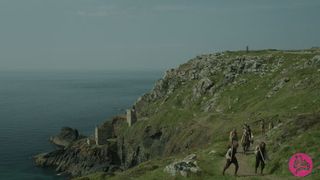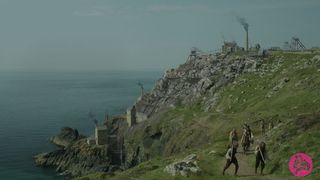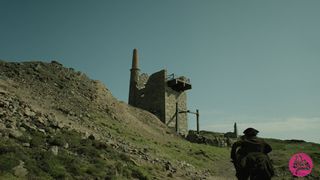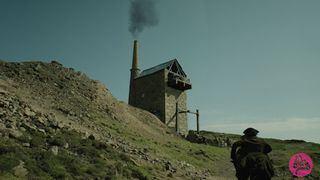The CG secrets of Poldark revealed
Downton Abbey veterans Lexhag explain how they met the VFX challenges of hit BBC show Poldark.
Period drama has always been popular, but since Downton Abbey it's experienced an explosion in demand. And more recent examples like Wolf Hall, Jonathan Strange & Mr Norrell and Ripper Street have benefitted from a healthy dose of VFX mastery that helps bring these bygone eras to vivid life.
One such example of this is the BBC's second reenvisioning of Poldark (the first airing too place between 1975 and 1977). This updated take on Winston Graham's historical novels tells the story of the eponymous Ross Poldark, who, in the late 18th century, returns from a three-year stint in the army to the tin mines of his Cornish hometown.
Don't miss the special TV edition of 3D World magazine - out now!
Dark, dramatic and oozing atmosphere, the story of Poldark is rich indeed, its narrative unravelling across the southern coasts of England across eight eventful episodes. It was the London-based studio Lexhag that brought this new vision to life for the BBC, using a mix of LIDAR scan technology, full-CG ship elements and the organisational capacity of ftrack.
Flair for drama
Based in London's Soho, Lexhag is a boutique studio with a speciality in the period drama genre. Previously, Lexhag has worked on shows as prestigious as Downton Abbey, The Mystery of Edwin Drood and The Paradise. It's also had forays into such alternative genres as zombie survival in Outpost III: Rise of the Spetznaz and psychological horror in Dementamania.
"We've worked on a lot of different things over the years, but I'd say 60-70% of our work is in drama – we're traditionally very strong there," says Dan Marbook, VFX producer at Lexhag. "We won an RTS Award and a BAFTA in 2012 for our work on The Fades."
Blockbuster values
For Hasraf Dulull, also VFX producer at Lexhag, TV drama today is reaching for ever higher production values, facing many of the same challenges as top-tier Hollywood blockbusters. "There's a lot more budget available for visual effects, and they're being incorporated into the production schedule with greater frequency to bring these historical worlds to life," he explains.
Get the Creative Bloq Newsletter
Daily design news, reviews, how-tos and more, as picked by the editors.
"What we're trying to do is make the TV executives think a bit differently about how VFX is used. VFX doesn't just mean post-production anymore – it's pre-production too. We need to be on board a lot earlier, the same as with feature films. And that's the kind of approach we're taking with projects like Poldark."
Keeping up to date with the latest technology is key to that, says Alexis Haggar, effects supervisor on the show. "Technology, as we know, is always pushing the quality of what can be done, mainly by providing a quicker way to achieve a photo-real result. Time consuming tasks; roto, tracking, keying, etc. are all getting quicker as camera technology and other gubbins get more advanced, leaving artists with more time to focus on the creative."
"So we use a mixture of ftrack for tracking and LiDAR, Maya and 3DS for most 3D tasks with Vray to render, while Nuke, Fusion and Mocha for most of our 2D tasks. Because we look after our own VFX live action plates, we used a combination of Sony RAW viewer, Resolve and Priemire for the pulling and processing of these plates.
Getting hands-on
Lexhag prefers to work not just as a post house, but as a second unit for productions, even going on set to capture their own VFX elements where necessary. "We did that on Downton Abbey for the Christmas special," says Marbrook. "Using those techniques means we can offer up shots that other facilities might not be able to at the price we offer. We really do think a great deal about how we're going to achieve the effects we're brought on to deliver…"
Poldark perfectly exemplifies this hands-on approach to VFX production. Among other tasks – which included the creation of everything from a full-CG butterfly up to a full-CG ship – the Lexhag team was brought on to enhance the rolling, panoramic shots of the English southern coast, which meant a blend of matte painting work and set extensions.
In order to accurately replicate the 1700s seafront, Lexhag used the latest in LIDAR technology to scan on-set elements.


"The investigation that we do into new types of techniques to be able to achieve what we want to do for our clients really is second to none," says Marbrook of Lexhag's work.
"We focus on using technologies that will really help streamline our business and produce the best work for the client, and that's why we're doing a lot of work with LIDAR scanners at the moment. They can geometrically map areas and buildings before we extend them in CG, so we know they are 100% accurate and will match up to the plate.
"A lot of our shot design and thought processes go into what real elements we can get into the camera first, so that's where the LIDAR implementation comes from. We're reluctant to just whack up green screens, even though they do have their value in the right time and place."
Authentic backdrops
The Lexhag team would use LIDAR technology to scan derelict buildings on the sweeping plains of Cornwall, and then use that data to build out the mines that once pocked the landscape in the late 1700s. The accuracy that this data gave the team enabled them to build fully believable, authentic backdrops for the series.
"LIDAR scanning is an architect and builders tool, really," says Marbrook. "It sends out either a long- or short-range scan using two million lasers that face out of the scanner. It gives you a complete reading that we can then feed into Maya or 3ds Max, giving us a digital map of that landscape, building or room.


"This gives us a lot of options – we can build a full digital environment out of it, or do some previs, or just use it as a snapshot of the scene to makes notes on. We can map still photography on top of those scans too, which means the textures are true to life. We'll then have an asset to utilise across the series that the production wouldn't have had otherwise."
Prepping and scanning
For Lexhag, preparation is key when working on a LIDAR scan, and the team hopes to incorporate production tracking tool ftrack into the process more in future: "We'd expect to be booked out for a day to go and prep and completely scan an area," says Marbrook.
"To give ourselves the best possible chance of success, the more preparation we do, the better. We're currently looking for ways to use ftrack to input our LIDAR scans. We supply sign-off documents back to production, which include the data we've collected from the scans, the photography, the shot compositions and pre-vis.
"We want that to be traceable through to the generation of the actual shot. That's next."
Next page: building the ship....

Thank you for reading 5 articles this month* Join now for unlimited access
Enjoy your first month for just £1 / $1 / €1
*Read 5 free articles per month without a subscription

Join now for unlimited access
Try first month for just £1 / $1 / €1
The Creative Bloq team is made up of a group of design fans, and has changed and evolved since Creative Bloq began back in 2012. The current website team consists of eight full-time members of staff: Editor Georgia Coggan, Deputy Editor Rosie Hilder, Ecommerce Editor Beren Neale, Senior News Editor Daniel Piper, Editor, Digital Art and 3D Ian Dean, Tech Reviews Editor Erlingur Einarsson and Ecommerce Writer Beth Nicholls and Staff Writer Natalie Fear, as well as a roster of freelancers from around the world. The 3D World and ImagineFX magazine teams also pitch in, ensuring that content from 3D World and ImagineFX is represented on Creative Bloq.
